
 |

|
|
|
|
Length: "tall" Eyes: Blue Marriages: (1) Elizabeth Catherine Bowen, actress (aka Billie Bowen) (Jun 20. 1917 NYC - Apr 7. 1920, divorced Chicago) (2) Eleanor Marguerite Durkin, actress (1921 - Sep 23. 1957, her death). Daughter (according to 1930 census adopted): Mary Lee aka Marylee (1929, Michigan - ) "Now" Mrs. Kofahl of Montrose. Brothers: Raymond, Thomas (actor), and Adrian (New York Judge) |
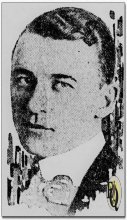 |
| Above right: James Michael Burke in 1920. | |
|
James Michael Burke was born on September 24. 1886 in
Manhattan, New York City as eldest son to Thomas Burke and Rose Daw. Tall Irish-American character actor started out in vaudeville and performed on stage in New York in 1912. It was upon advice of Max Winslow he formed a vaudeville act called "Burke & Harris" (1913). They were immediately engaged by Mr. Jos. M. Schenck under a forty-week contract. They continued working on the Marcus Loew Circuit ever since. Considered by many to be the best two-man singing act, their act stands as absolutely clean and delightful entertainment. "They have a wonderful appearance, classy clothes, and best of all the ability to wear them." The use of the song My Bird of Paradise had the biggest return of any song in their repertoire. Not only was it a hit, but it also "stopped" their act. Harris declared that he never had a song better suited to him. Burke used I'm Going Back to the Farm, which resulted in favorable comments from the audiences. They became known as the boys from Coney Island's "The College Inn" when they started an eight months contract late October 1915. In the Summer of 1916 Jimmy Burke supervised "The Harvard Inn" (formerly Kelly's), Burke and Harris were the featured attraction at the Harvard, with Anna Gould and Frankie Gold as chief support. James and Ralph were described as two cabaret singers, who sang pop songs (ragtime!) with a couple of character numbers added. They looked well en also did well, there act was called Stories from Life in Song. For a while they even performed as a trio "Harris, Burke and Harris" (1916) reappearing as a duo one year later performing together as late as December 1917. With WWI raging Jimmie/Jimmy as he was known around his home, at 1250 St. Nicholas Avenue, was one of those lads who, wave a hand to Broadway and the electric lights and proceeded to do a lot towards nailing that old one about actors being "good for nothing but to act." He filled in his draft registration on June 1. 1917. |
|
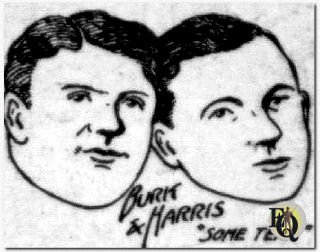 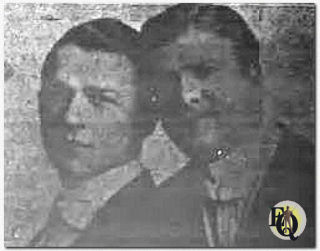 Above left: (R to L) "Burk & Harris" (sic) in Some Team (1914). Above right: (L to R) "Burke and Harris" (1915). |
|
|
Shortly thereafter, our "Jimmy" met Billie Bowen, an actress at the Garden Cabaret in New York. Reportedly, after just three days, on June 23. 1917, on a dare, they got married! Their marital life ended after three weeks when he enlisted in the army. He underwent training at Camp Wadsworth in Spartanburg, S.C. (company I, 52nd Pioneer infantry Regiment ****). Jim(my) Burke who held the rank of top Sergeant (aka "scrappin' sergeant") served 18 months
(1917 - 1918), 8 months
in France and 10 months in hospital... He spent 10 months in a French Hospital and later Staten Island. It was there in the Fox Hill hospital for invalided soldiers that he first met Miss Durkin. She was entertaining the soldiers with he songs. Eleanor Marguerite Durkin, originally from Kansas, worked in vaudeville and was part of "The Durkin Sisters" **, a musical comedy act. By the end of 1919 Burke emerged limping and wabbling a bit, but ready to throw off his old khaki and get back behind the footlights. He dropped into a song publishing office one day and casually remarked that he'd soon be back on the stage. Of course, he had no idea Miss Durkin was within a hundred miles of the place, but as he turned to leave he came face to face with that young woman! She remembered him and he remembered her, and the two decided their voice would go well together, and why not try a turn in the two-a-day? So by the end of 1919 and in the early months (February - May) of 1920 Burke was back touring the Central West and South whilst performing in vaudeville. James Burke and Eleanor Durkin performed together a vaudeville routine of songs and chatter initially without a title for their act or were sometimes subtitled as "A Boy - A Girl -A Piano and Some Songs". Around the Summer of 1920 they started naming the act A Tête-à-Tête in Song * (aka Music and Chatter, 1920 - 1924). |
|
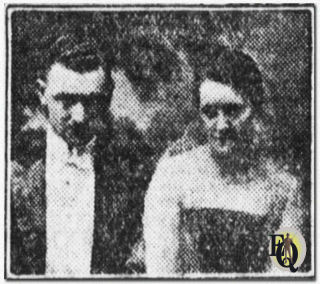 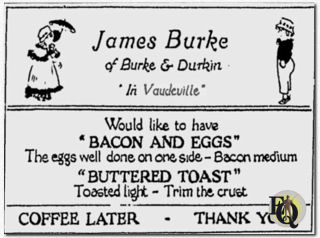 Above left: Jimmy Burke and Eleanor Durkin, Loews Lyceum (Jan. 1920) Above right: Throughout his vaudeville years Burke used to carry a supply of cards and would hand them to waitresses who came for his order. The waitresses would take them to the chef, who always laughed, kept the card, but followed instructions. "James Burke of Burke and Durkin, in vaudeville, would like to have bacon and eggs, the eggs well done on one side, the bacon medium; buttered toast, toasted light, trim the crust; coffee later. Thank you." |
|
|
Upon his return, he had found his wife living in luxury,
and her only explanation was that 'Bert' was paying her expenses. This
information was given to Attorney Benjamin Ehrlich by Burke, who filed
suit for divorce in February 1920 in the Circuit Court against Mrs.
Elizabeth Catherine Burke, charging desertion. By April 1920 James was
granted a divorce. Their 20 minutes program evolved over time but sufficient descriptions remain. Burke gave an "edition de luxe et de comedie" of the "Home Again Blues". He then demonstrated how a possible proposal of marriage would take place in 1940. In that case the woman proposed to the man. One of the best bits was Burke's impression of Bert Williams singing You Cannot Make Your Shimmy Shake of Tea. The act closed with a comedy song, When Frances Dances with Me. Burke was praised for "his ability to handle his feet'. His forte was coon songs but he could also handle tough kid songs. If I Could Only Think written by Teddy Wild, was a new skit of song and patter for James and Eleanor was offered starting October 1924 in Albany, NY playing Glens Falls the last half. Special songs in the act by Gilbert Wells and J. Rosamond Johnson. |
|
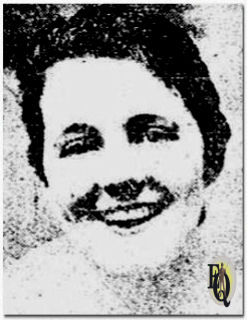 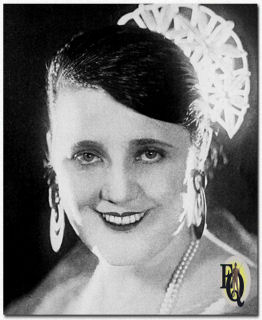 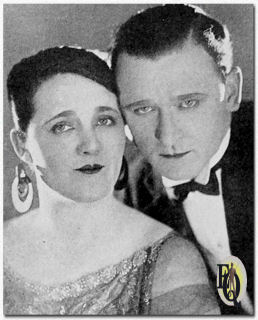 Above left: Miss Eleanor Durkin, who will sing and dance with James Burke, war veteran, at B.F. Keith's "Palace Theatre" (1921). "Incidentally, Eleanor Durkin has the cutest little laugh when she becomes enraptured with her 'Jimmy's' performance. At that moment, you can see Eleanor grin, but it's her laugh that truly matters." Above middle: Eleanor Durkin part of Harry Weber Attractions (1925). Above right: Promo for Harry Weber Attractions: James Burke and Eleanor Durkin in If I Could Only Think by Ted Wilde (1928). "A striking looking female companion Miss Durkin in appearance rivals almost any female in vaudeville and none can put more originality into a song than Mr. Burke and it is a genuine pleasure to note the unique manner he brings into play in the way he uses 'I Miss My Swiss' and 'For Crying Out Loud'." |
|
|
Early 1927 they were seen in theaters on the West Coast trying out a new routine: Paying Off the Second Mortgage (Orpheum, Jan 27. 1927). "Burke and Durkin" were part of an overall program. This was part of "Innovation Week" at the Orpheum, where instead of a show of consecutive individual acts, Herman Timberg put together one show with 6 to 8 acts in which the performers also interacted with each other. The whole thing was not received positively by critics. On March 31. 1927 it was reported that James and Eleanor, Keith and Orpheum circuit vaudeville stars, had returned to their New Rochelle home after a tour of the West, including Hollywood, and that they may return to the film colony within a few months to take parts offered to them by a producer who saw them on the stage in Los Angeles.
As announced on October 31. 1928, the C.B. Maddock unit truly began in
March 1929 with a show called Topical Topics
(aka Typical Topics), led by Burke
and Durkin. Their group consisted of approximately 25 members, including
the main performers and a chorus of 12. It ran for 80 minutes at the
Jefferson. The concept was a repeat of the innovation they were part of
on the West Coast. Two mixed teams formed the body of the show, with
Burke serving as the master of ceremonies and presiding in a supervisory
capacity, in addition to the regular specialty of the pair near the end
of the evening. Critics were harsh, stating, "Lots of loose material
presented in rather a jumble. Still needs knitting." Meanwhile, they continued to perform with If I Could Only Think until they were announced in an act called Just Ourselves by November 1929. According to the census of April 1930, James resides in New York with his wife (and in-laws) and their newly adopted daughter. During their performances in 1930 (Jun - Aug) Burke now was imitating Maurice Chevalier with the song Nobody's Using it Now. By the end of October 1930 they were performing A Tête-à-Tête in Song* in Eleanor's home town Kansas City. Presumably, shortly thereafter, the couple traded the East Coast for the West Coast and Hollywood. He quickly became known for portraying rugged police officers with Irish accents, often given names such as Muldoon, Mulligan, Kelly, Maloney, or Burke (!). When not portraying the dense law enforcer or the understanding, compassionate officer, he occasionally appeared in period films in minor roles as soldiers or guards. For years, he was a reliable choice in Hollywood for roles as city police officers, which he portrayed with a wry smile and vibrant accent. Burke starred in several comedies starring W.C. Fields (1933 - 34). Many of his film roles up to 1935 were uncredited. Brief Candle (Oct 23. 1933) was a comedy drama for stage produced by the Beverly Hills Little Theatre. James Burke played a hard-boiled sailor and garnered most of the laughs, displaying his vaudeville delivery in handling gag lines. "The piece is unsatisfactory theater, starting nowhere and ending in the same place." (Variety) In Frank Capra's It Happened One Night (Columbia, Feb 18. 1934) he (again uncredited) played a detective opposite Clark Gable and Claudette Colbert. One of his best roles was as Charles Ruggles' rowdy rancher pal in Ruggles of Red Gap (Paramount, Mar 8. 1935). |
|
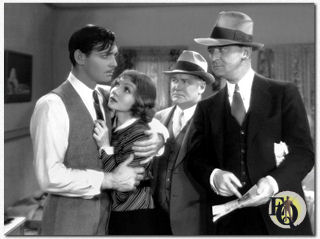 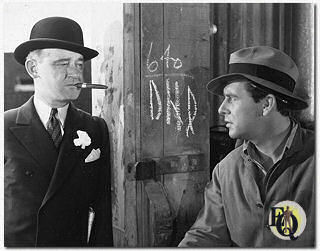 Above left: Clark Gable, Claudette Colbert, Joseph Crehan, and James Burke in It Happened One Night (Columbia, Feb 18. 1934), directed by Frank Capra. Click on photo for clip... Above right: Frisco Waterfront (Republic, Dec 3. 1935) Starring Helen Twelvetrees, James Burke (L) portrays a political boss in the film. He offers Glenn Burton, played by Glenn Lyon (R), his initial opportunity in the District Attorney's office, expressing some seemingly benevolent sentiments tinged with cynicism. |
|
|
In October 1935 Eleanor was recuperating at the Pasadena Hospital after a major operation only to return home by November just when Burke signed for Song and Dance Man (20th Century-Fox, Mar 11. 1936), in which he appeared with Ruth Donnelly and Claire Trevor. Vaudeville was never far away. In February 1936, it
was reported that James temporarily turned to writing. He penned a
vaudeville act which Regis Toomey would take on the road. Burke also
wrote another act currently starring Toby Wing, incorporating one of the
special songs his wife sang in vaudeville: Girls Never Be Brilliant,
Be Dumb. |
|
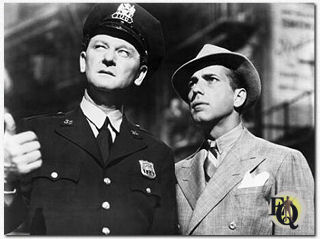 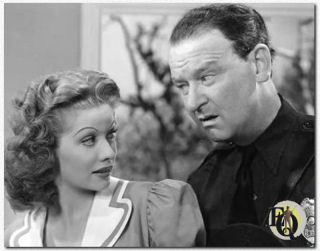 Above left: Burke (L) as Mulligan with Humphrey Bogart (R) in film Dead End (United Artists, Aug 27. 1937) Above right: James Burke (Muldoon) with the very talented Lucille Ball in the comedy The Affairs of Annabel (RKO Radio Pictures, Sep 9. 1938). |
|
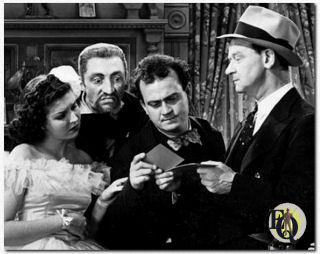 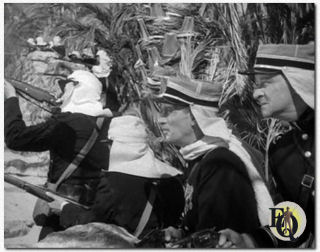 Above left: You Can't Take It with You (Columbia, Sep 29. 1938) had James Burke in the uncredited role of Chief Detective. Click on photo for clip... Above right: In Beau Geste (Paramount, Jul 24. 1939) Major Henri de Beaujolais (James Stephenson) (middle) and his deputy Lieutenant Dufour (James Burke) have revolvers. |
|
|
Between 1940 and 1942, James Burke played Sergeant
Velie in all
seven
Ellery Queen movies by Larry Darmour Productions.
In the first four, he acted alongside
Ralph
Bellamy (as Ellery Queen) and
Charley Grapewin (as
Inspector Richard Queen), and in the last three movies, he acted
alongside William Gargan,
who took over the lead role from Ralph. There were no changes in his
character, which one critic described as "Sergeant Velie, whose feet
are almost as flat as his head!" The series was not a success. |
|

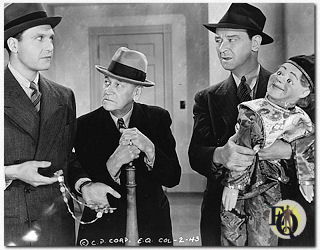 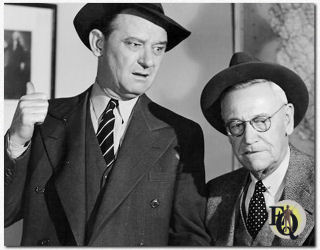 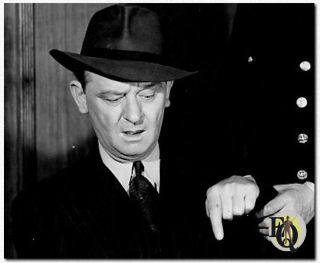 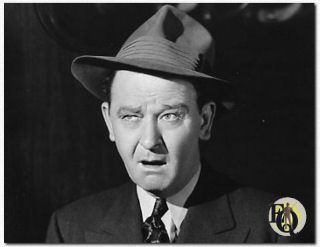 Top left: Ralph Bellamy (Ellery Queen), Charley Grapewin and James Burke (Sgt.Velie) in a scene from The Penthouse Mystery (Columbia, Mar 24. 1941). Top right: Sergeant Velie (James Burke) explains to Inspector Queen (Grapewin) in A Close Call for Ellery Queen (Columbia, Jan 29. 1942). Above left: James Burke in A Desperate Chance for Ellery Queen (Columbia, May 7. 1942). Above right: Enemy Agents meet Ellery Queen (Columbia, Jul 30. 1942). |
|
|
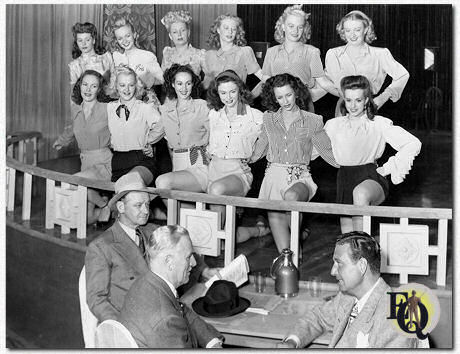 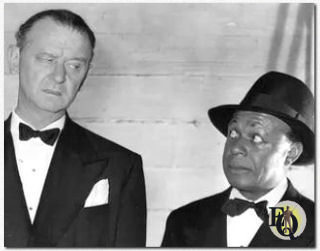 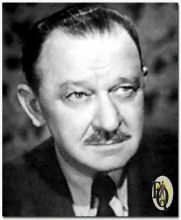 Top: Glorious photo from I Love a Bandleader (Columbia, Sep 13. 1945) with seated (L-R): James Burke, Pierre Watkin, and Phil Harris. Above left: James Burke with Eddie "Rochester" Anderson in an unknown scene, probably from 1945's I Love a Bandleader (Columbia, Sep 13. 1945). Above right: James Burke in a 1947 publicity shot for United Artists. |
Burke took very little radio work. So his appearance on Family Theatre
("Substitute Santa", Mutual, Dec 11. 1947), a
Christmas story set in the backdrop of a busy store, was rather exceptional. In the early 1950s (1951 - 53), Burke appeared
as Sgt. Tim Malloney with Tom Conway in the
ABC detective drama series then called Inspector Mark Saber -- Homicide
Detective, later renamed, reformatted, and switched to NBC under the title
Saber of London. In the early 1950s (1951 - 53), Burke appeared
as Sgt. Tim Malloney with Tom Conway in the
ABC detective drama series then called Inspector Mark Saber -- Homicide
Detective, later renamed, reformatted, and switched to NBC under the title
Saber of London.Radio's successful Duffy's Tavern (MPTV) finally made it to TV in 1954. James played Clancy, the Irish Cop, in at least 6-7 episodes. Alan Reed, who had played that part on radio, was cast now as the somewhat dim-witted character Finnegan. |
| Above right: James Burke (date unknown, ca. 1955). |
|
Eleanor Burke, died on September 23. 1957 in the couple's home at 5266 Alta Canyada Road, La Cañada, Flintridge, Ca. She had been in failing health in recent years and succumbed to pneumonia. From 1960 - 1961, Burke appeared in the role of Zeke Bonner in, at least, twenty episodes of the ABC western television series Stagecoach West, starring Wayne Rogers, Robert Bray, and Richard Eyer. In Lassie he played in two episodes: "The Trip" (CBS, Jan 29. 1961, as the train conductor) and "Lassie's Good Deed"(CBS, Apr 29. 1962 as Mr. Jensen a WWI veteran). |
  Above left: Jim Burke as "Zeke Bonner" in "The Marker" an episode of Stagecoach West (ABC, Jun 27. 1961). Above right and below: "Lassie's Good Deed" (CBS, Apr 29. 1962). Jon Provost portrays Timmy Martin, and James Burke portrays Mr. Jensen, a World War I veteran who lives as a recluse in the woods. Mr. Jensen befriends Timmy, but unfortunately, he is hit by a car and falls into a coma. Lassie, being the loyal companion she is, sneaks Mr. Jensen's little dog into the hospital to provide comfort and companionship during his time of need. |
|
He made his last known appearance in The Law and Mr. Jones where he was seen in the episode "The Walkout" (ABC, May 10. 1962). Burke worked in television, until his retirement at 80. Burke suffered from a heart condition, which took his life at the age of eighty-two. He died on May 23. 1968 in the Sepulveda Veterans Hospital, Los Angeles. While he played in a great many feature films and also worked for TV in recent years, most obituaries barely mentioned the big or small screen. Most newspapers had this brief message: "Vaudevillian Dies. La Cañada, Calif. James Burke, 85 old-time vaudeville star who appeared in numerous motion pictures and television shows, died Friday. He and his wife Eleanor were popular in vaudeville as the team of 'Burke and Durkin'." It would have made the old Vaudevillian very proud I'm sure. |
 |
|
Notes: * Name variations for the act appear in newspapers of that time: A Tet-a-tete of Song (sic), sometimes with 'Songs' (in plural). The most common version being A Tête-à-Tête in Song. The 1929 Vitaphone movie was definitely named A Tête-à-Tête in Songs. ** "Nellie" (a name she herself didn't like to hear) formed "The Durkin Sisters" together with her sister Kathryn. Kathryn Emmeline married (Feb 21. 1918) Quinn Martin, a film critic of The New York Tribune and The New York World. Quinn became a member of the Fox writing staff (1930 - 1931) which lead them to move west. Their father Thomas Peter Durkin and mother Emma A. Wilcox often traveled with them on tour. *** These 'talkies' made use of the sound on disc process and at the time, there was much fear that these little films would kill vaudeville. The chance always existed that a stage performer appearing in it would become famous, and so in every city, as soon as the film was shown, he or she could no longer bring their act to the stage. A fear that was justified for many individual performers. Perhaps also the reason why they did not film their current program. **** 52nd Pioneer Infantry started as the 12th NY Infantry and were organized Jan 1918 at Camp Wadsworth, South Carolina. To Camp Merritt, New Jersey, July 1918 and to Port of Embarkation (Hoboken) August 1918. Overseas from August 1918 to April 1919. Demobilized at Camp Dix, New Jersey, April 1919. Directly under First Army (American Expeditionary Forces) from its arrival until September 17. (or maybe 16.) 1918 then transferred to V Corps for the Meuse-Argonne Offensive and German occupation until sent home. All dates for movies are for the first US release. All dates for TV programs are original first airdates. All dates for (radio) plays are for the time span the actor was involved. Facts in red still need confirmation. |
|
Click on Uncle Sam if you think you can help out...!
|
|
Other references (1) Wikipedia (2) IMDb (3) RUSC (4) OTRRpedia (5) Radiogoldindex Additional video & audio sources (1) Marc Saber Clip from TV Episode January 27. 1957 (2) It Happened One Night Clip Film, 1934 (3) You can't take that with you Clip Film 1938 (4) The Maltese Falcon Clip Film 1941 (1:06) (5) Lassie episode Lassie's Good Deed 1962 full episode (2:06) (6) Knock on Every Door (1958) movie (short) (James at 11:20) (7) Lassie episode "The Trip" 1961 full episode (8) Are Husbands Necessary? 1942 full movie (Eleanor at 42:50 and James at 58:22) (9) The Mad Miss Manton 1938 Clip with Burke singing "Home on the Farm" |
|
This actor profile is a part of
Ellery Queen a website on deduction.
The actor above played Velie in a
movie series of
Ellery Queen.
Click Uncle Sam if you think you can help
out...! Many of the profiles on this site have been compiled after very careful research of various sources. Please quote and cite ethically! |
|
Page first published on January 1. 2016 Version x2.2 - Latest update April 24. 2025 |
 b
a c k
t o L i s t o f S u s p
e c t s
b
a c k
t o L i s t o f S u s p
e c t s
|
|
| Introduction | Floor Plan | Q.B.I. |
List of Suspects | Whodunit? | Q.E.D. | Kill as directed | New | Copyright Copyright © MCMXCIX-MMXXV Ellery Queen, a website on deduction. All rights reserved. |